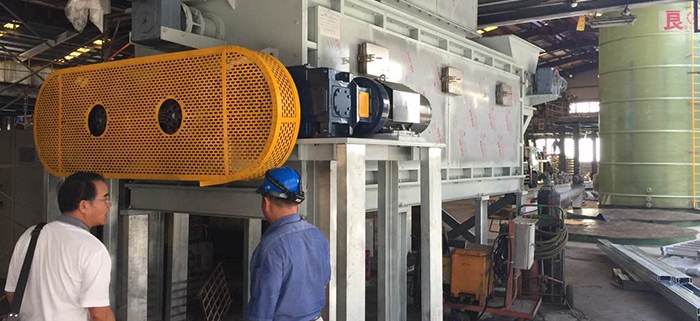The rotary vacuum paddle dryer is a jacketed cylindrical container with a large diameter hollow shaft, connected to the shaft is a hollow blade with a specially designed scraper that scrapes the entire inner surface of the dryer And continuously moving and rotating the material to eliminate the possibility of the material remaining in contact with the hot surface for a long time.
The jacket with the blades and the hollow shaft can be heated with hot water, steam or any other hot fluid capable of providing a large indirect heat transfer area. It can also be cooled by water, brine or any other refrigerant through the jacket and hollow shaft. If a liquid heating medium is used, a coil can be provided instead of the sheath. The hard surface of the shaft is placed in the gland packing area of the trunnion to provide a nitrogen purge arrangement. A pulsating bag cleaning device is provided by a nitrogen ejector.
Heavy-duty bearings and bearings support hollow shafts (mixers), which are supplied by motors that reduce the gear train and sprocket. It is also provided that four crush bars are inserted into the dryer housing to reduce the particle size. In special cases, a fixed scraper can be provided to discard the rotary agitator for highly viscous materials.
working principle
Rotary vacuum paddle dryer has the advantages of high technology content, high standardization, environmental protection, safety, low consumption, simple maintenance, etc. In the design structure:
The top of the rotary vacuum dryer is equipped with a classifier. By changing the hole diameter of the classifier and the height of the classification section, the air flow rate is changed, and the particle size and quantity leaving the dryer, the final water content and the material in the drying section are controlled. Stay time. The bottom of the rotary vacuum paddle dryer is provided with an inverted cone structure, so that the cross section of the drying gas gradually expands from bottom to top, the bottom airflow is relatively large, and the upper airflow is relatively small, thereby ensuring that the lower large particles are in a fluidized state. The upper small particles are also in a fluidized state, and the hot air is rotated along the vertebral body, the bottom wind speed is increased, the length of the cantilever portion of the stirring shaft is reduced, the safety and reliability of the operation are increased, and the bearing can be placed outside the machine, effectively Prevents the bearing from working in the high temperature zone, thus extending the service life of the bearing.
The number of revolutions of the rotary shaft of the rotary vacuum dryer is controlled by a stepless speed regulating motor. Different speeds are selected according to the product particle size requirements. The faster the stirring shaft speed, the smaller the particle size of the obtained product. A scraper is arranged on the stirring tooth, and the material is thrown to the wall of the machine while being crushed by the stirring tooth, and is bonded to the wall surface. If it is not scraped in time, the equipment may vibrate in severe cases, and even the stirrer may be suffocated. A scraper is arranged on the stirring tooth to peel off the material adhering to the machine wall in time to avoid sticking.
The number of revolutions of the screw conveyor of the rotary vacuum paddle dryer is controlled by an inorganic speed control motor. The feed rate is controlled according to the nature of the material and the drying process parameters. The flash dryer has compact structure, small footprint, integrated drying, pulverization and grading. It is an organic combination of swirling technology, fluidization technology, spray technology and convection technology. It does not need to be crushed or sieved after drying. Simplifies the production process and saves on power and equipment costs.
Design and application of rotary vacuum paddle dryer
A rotary vacuum paddle dryer is a drying system for obtaining dry powder from a wet cake or solution. The drying operation is usually a batch process and is usually carried out under vacuum, heating the product by direct contact with the heating vessel and the surface of the agitator. The heating of the dryer can be accomplished by using steam or a suitable heat transfer fluid.
The paddle dryer is designed to withstand the stresses caused by vacuum and temperature cycling in various heating components. The standard design of the paddle dryer system includes a dust collector, condenser, receiver and vacuum pump. Other features include:
Hollow shafts and blades: Hollow rotary mixers provide heat to the product, scrape the shell wall, flip the product to a large extent to transfer heat, and discharge the product when needed.
Drain valve: User-friendly design provides a tight vacuum closure during material processing and quick opening of the bag during material removal and packaging.
Rotary vacuum paddle dryer process design method
The new equipment of rotary flash dryer adopts a variety of advanced devices. For example, a variety of feeding devices are used to make the feeding continuous and stable, and the feeding process does not cause bridging; the bottom of the dryer uses a special cooling device to avoid the material in the bottom high temperature zone. Sticking wall and deterioration phenomenon occur; special air pressure sealing device and bearing cooling device are used to effectively extend the service life of the transmission part; special air separation device is adopted to reduce the resistance of the equipment and effectively provide the treatment air volume of the dryer; drying room It is equipped with a grading ring and a swirling plate to adjust the fineness and final moisture of the material. The stirring and pulverizing device is used to produce strong shearing, blowing and rotating effects on the material; air filter, cyclone separator, bag filter, etc. are used. Effectively remove dust and avoid environmental and material pollution. The device has strong mass transfer heat transfer, high production intensity, short drying time and short material residence time.
First, the determination of the drying room
Rotary vacuum paddle dryers process the evaporation intensity of some materials. The volumetric heating method is the theoretical design method of rotary flash dryer. However, the key volumetric heat coefficient in this method is difficult to determine, so it lacks operability. Evaporation intensity method is an indirect method of volumetric heating method. It can be calculated as long as there is certain experimental data. It is a method commonly used in industrial design. The evaporation strength method calculates the volume of the drying chamber based on the amount of evaporated water and the evaporation strength, and calculates the effective height based on the relationship between the diameter and the height.
Second, the diameter of the drying chamber
Another method is to calculate the required air consumption by material balance and heat balance, and then determine the diameter of the dryer according to the air speed range.
Third, the height of the dryer and the graded particle size
The hot air from the hot air distributor enters the drying chamber through the annular gap in a tangential direction, and the material in the drying chamber is spirally rotated and raised under the action of the hot air blowing and the agitator. When studying the fluid motion of smaller particles under the action of the centrifugal force field, the effect of gravity is small and therefore negligible.
Fourth, the application of rotary vacuum pad dryer
The operating conditions of the partial rotary vacuum pad dryer, the upper part of the drying chamber is provided with a step ring, the main function of which is to separate the material with large or no dry particles from the qualified product, and the product can effectively ensure the product size and moisture requirement in the drying chamber. . Replacing the grading rings of different diameters can meet the product size requirements. Cold air protection is provided at the hot air population at the bottom of the cone to prevent the material from coming into contact with high temperature air to cause overheating. The drying system is closed and operates under micro-negative pressure. The dust does not leak, protecting the production environment, and being safe and hygienic.
Rotary vacuum paddle dryer is mainly composed of air inlet system, heating system, feeding system, drying host, receiving dust removal system, exhaust system and control system. During operation, the wet material enters the drying chamber by the screw feeder, and the material meets the hot air rotating at high speed in the drying chamber, and the fine powder material is moved by the hot air to the upper end of the drying chamber, and the material that cannot be taken falls at the bottom of the drying chamber. It is broken by the crushing device at the bottom, the material is quickly dispersed, and the contact area between the material and the hot air is rapidly increased. Under the action of centrifugal force (with a classification device at the top), the product that reaches the degree of dryness and a certain degree of fineness is blown out of the classifying device, and the material is quickly dried in the process.



